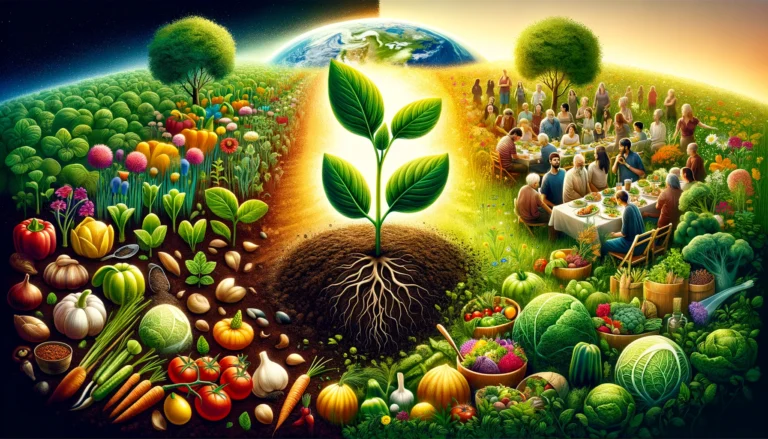In the quest for self-sufficiency, homesteaders embrace a lifestyle that is both rewarding and challenging, requiring a diverse set of skills and knowledge. This way of life is not just about living off the land but also about fostering a deep connection with nature, understanding the cycles of growth and renewal, and taking an active role in managing the resources available.
The essence of homesteading lies in the ability to do things yourself, from growing your own food and raising animals to repairing buildings and making clothes. Each skill acquired and mastered is a step towards greater independence and sustainability, contributing to a lifestyle that is not only environmentally conscious but also deeply personal and fulfilling. Homesteaders learn to observe the natural world, adapt to its rhythms, and make the most of its bounty through creativity, hard work, and a commitment to learning.
The DIY skills essential for successful homesteading span a wide range of activities, each contributing uniquely to the homestead’s overall functionality and resilience. These skills include gardening and composting to enhance soil fertility and produce abundant harvests; canning and preserving to ensure food security year-round; carpentry for building and maintenance projects; and animal husbandry for a supply of fresh meat, eggs, or milk.
Additionally, water harvesting and management, basic electrical and plumbing work, sewing and mending, foraging and wildcrafting, natural medicine, mechanical repair, and sustainable energy solutions are all critical for reducing dependency on external resources. Mastering these skills not only ensures the physical well-being of the homesteader and their family but also nurtures a sense of accomplishment and a deep appreciation for the intricacies of living closely with the land.
1. Gardening and Composting
Gardening is the cornerstone of homesteading, allowing you to produce fresh, organic food. Gardening on a homestead involves growing your own fruits, vegetables, and herbs, which requires knowledge in soil health, plant selection, and natural pest management. Composting is a sustainable practice that recycles organic waste into rich soil amendments, improving garden health and productivity. By balancing green (nitrogen-rich) and brown (carbon-rich) materials in a compost pile, homesteaders can create a nutrient-rich compost that benefits the soil and plants, reducing the need for chemical fertilizers. Essential aspects include:
- Soil Preparation: Learning how to test and amend soil with natural fertilizers to create the best growing conditions.
- Plant Selection: Choosing crops suited to your climate and soil. Incorporating perennials can offer long-term yields.
- Pest and Disease Management: Implementing companion planting and natural predators to keep pests at bay without chemicals.
Composting turns kitchen and garden waste into rich soil. Key points include:
- Balance: Maintaining a good balance of ‘greens’ (nitrogen-rich materials) and ‘browns’ (carbon-rich materials) for effective decomposition.
- Aeration and Moisture: Regularly turning the compost to introduce oxygen and keeping it moist to encourage microbial activity.
2. Canning and Preserving
Preserving food extends the bounty of your garden. Canning and preserving food are essential skills for extending the shelf life of the produce from your garden or local markets. These practices include techniques like water bath canning for acidic foods, pressure canning for low-acid foods, drying, and fermentation. Mastering these methods allows homesteaders to enjoy their harvests year-round, provides food security, and supports a sustainable lifestyle by minimizing food waste. Techniques include:
- Water Bath Canning: Best for high-acid foods like fruits, tomatoes, and pickles. It involves boiling jars to seal them.
- Pressure Canning: Used for low-acid foods like vegetables and meats, requiring a specialized pressure canner.
- Drying: Dehydrating herbs, fruits, and vegetables for storage. Solar dehydrators can be DIY projects.
- Fermentation: Making sauerkraut, kimchi, and fermented beverages. It’s simple and adds beneficial probiotics to your diet.
3. Basic Carpentry
Carpentry skills enable you to build and repair structures. Basic carpentry skills enable homesteaders to build, repair, and maintain structures on their property, from chicken coops to greenhouses. Knowledge of using hand and power tools safely, understanding construction materials, and the ability to follow or create plans are foundational. These skills not only save money but also allow for customized solutions to meet the unique needs of the homestead. Focus on:
- Tool Proficiency: Knowing how to safely use saws, hammers, drills, and measuring tools.
- Project Planning: Drawing up plans and calculating materials needed for projects like raised garden beds or a greenhouse.
- Joinery Techniques: Learning basic joinery, such as dovetail or mortise-and-tenon, for strong constructions.
4. Animal Husbandry
Animal husbandry is the care and management of livestock such as chickens, goats, and bees, which are often part of a sustainable homestead. This skill involves understanding the specific needs of each type of animal, including their diet, breeding practices, and healthcare. Successful animal husbandry contributes to the homestead’s self-sufficiency through the production of meat, eggs, dairy, and honey. Raising livestock requires knowledge in:
- Nutrition: Understanding the dietary needs of different animals to keep them healthy.
- Breeding: Knowing the basics of selective breeding and caring for pregnant animals and newborns.
- Healthcare: Recognizing signs of illness and administering basic treatments or vaccinations.
5. Water Harvesting and Management
Effective water harvesting and management practices are crucial for ensuring a reliable water supply for irrigation and household use, especially in areas prone to drought. Techniques include collecting rainwater from rooftops into storage systems and utilizing greywater for irrigation. Efficient water use reduces reliance on external water sources, saves money, and supports sustainable living. Efficient water use is critical in homesteading:
- Rainwater Collection: Setting up systems to capture rainwater from rooftops for irrigation.
- Greywater Systems: Reusing water from sinks, showers, and washing machines for non-potable uses.
- Irrigation Techniques: Implementing drip irrigation or soaker hoses to maximize water efficiency in gardens.
6. Basic Electrical and Plumbing Work
Homesteaders with basic electrical and plumbing skills can perform repairs and installations, saving on professional service costs. This includes tasks like fixing leaky faucets, installing new light fixtures, and running additional outlets. These skills enhance a homestead’s functionality and safety, and empower homesteaders to tackle emergencies and upgrades alike. Being able to handle minor repairs can be invaluable:
- Electrical: Installing light fixtures, running new outlets, and understanding your home’s electrical system.
- Plumbing: Clearing blocked drains, replacing faucets, and installing simple water-saving systems.
7. Sewing and Mending
Sewing and mending are valuable skills for extending the life of clothing and household textiles, reducing waste, and saving money. Beyond basic repairs, these skills enable homesteaders to create custom garments, curtains, and bedding, adding a personalized touch to the homestead while promoting sustainability through the reuse and repurposing of materials. Textile skills extend the life of clothing and household textiles:
- Basic Sewing: Repairing tears, replacing buttons, and hemming pants.
- Advanced Projects: Making your own clothes, curtains, or bedding from scratch or repurposed materials.
8. Foraging and Wildcrafting
Foraging and wildcrafting involve safely identifying and harvesting wild plants, mushrooms, and herbs for food, medicine, or other uses. These skills connect homesteaders with their local environment, offering access to natural resources and diversifying their diet and medicinal supplies. Sustainable practices ensure that foraging has minimal impact on the ecosystem. Safely gathering wild food and materials:
- Identification: Learning to identify edible and medicinal plants and mushrooms.
- Sustainable Harvesting: Taking only what you need and leaving enough for the plant to regenerate.
9. Natural Medicine
Knowledge of natural medicine and herbal remedies allows homesteaders to treat common ailments with plants grown in their garden or foraged from the wild. This skill includes creating tinctures, salves, and teas, and understanding the medicinal properties of various plants. It promotes a holistic approach to health care that complements modern medicine and reduces reliance on commercial pharmaceuticals. Using plants for basic healthcare:
- Herbal Remedies: Creating tinctures, salves, and teas from plants for common ailments.
- First Aid: Knowing how to treat minor injuries with natural remedies.
10. Mechanical Repair
Mechanical repair skills are essential for maintaining and fixing farm equipment, vehicles, and tools, ensuring they are in good working condition. This includes basic engine maintenance, tire repairs, and sharpening tools. The ability to perform these tasks can save significant money and downtime, keeping the homestead running smoothly. Maintaining and repairing machinery:
- Vehicle Maintenance: Basic car and tractor maintenance, such as oil changes and tire repair.
- Tool Care: Sharpening blades, fixing power tools, and ensuring all equipment is in good working order.
11. Sustainable Energy Solutions
Implementing sustainable energy solutions, such as solar panels or wind turbines, reduces energy costs and decreases reliance on the grid. This skill involves understanding how to harness, store, and efficiently use renewable energy. It is crucial for homesteaders aiming for energy independence and environmental sustainability. Implementing renewable energy:
- Solar Power: Installing solar panels and batteries to generate electricity.
- Wind Energy: Setting up small wind turbines for additional power generation.
- Energy Efficiency: Upgrading insulation, sealing leaks, and using energy-efficient appliances to reduce overall energy needs.
Homesteading is not just a series of tasks but a way of life that embodies the principles of sustainability, self-reliance, and harmony with nature. The journey towards self-sufficiency is paved with learning and growth, where each new skill acquired opens the door to deeper understanding and greater independence.
These essential DIY skills are the building blocks for a resilient homestead, enabling individuals and families to thrive in a lifestyle that prioritizes ecological balance and personal fulfillment. Through the seasons, homesteaders experience the joys and challenges of this lifestyle, from the satisfaction of a bountiful harvest to the trials of unexpected repairs, each moment a lesson in resourcefulness and perseverance.
As we look towards a future where sustainable living becomes increasingly important, the homesteading model offers valuable insights into how we can live more harmoniously with our environment. The skills outlined here are not only practical but also enriching, fostering a sense of connection to the earth and to each other that is often missing in modern life.
In embracing these practices, homesteaders of all levels contribute to a legacy of stewardship and sustainability that can inspire future generations. Whether you’re a seasoned homesteader or just beginning to explore this rewarding lifestyle, the journey towards self-sufficiency is a profound testament to the human spirit’s adaptability, creativity, and enduring connection to the natural world.


